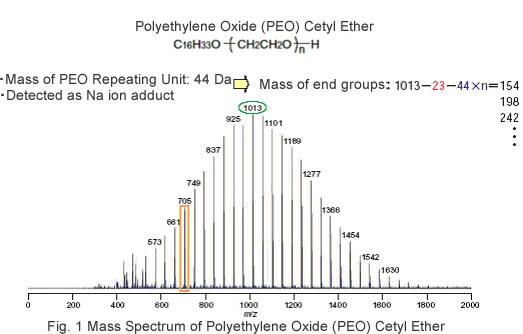Structural Analysis of Surfactants (TOF MS)
MALDI-TOF MS is widely used for analyzing the structure of various industrial materials. Performing MS analysis can provide information about the mass of polymer repeating units or the residues on both ends. Performing MS/MS analysis can provide information about the structure of sub-parts of the polymer.
In this example, the nonion surfactant polyethylene oxide (PEO) cetyl ether is analyzed.
The MS spectrum (Fig. 1) confirms that the mass equivalent of the PEO repeating unit is 44 Da, but the total mass for both ends cannot be confirmed. Normally, this is analyzed in combination with other information, such as 1H-NMR or IR spectra, but in this example, MS/MS analysis using the high-energy CID method is tried. Fig. 2 shows the MS/MS spectrum for m/z 705 as the precursor ion. It confirms the group of peaks from the alkyl end group, appearing at 14 Da intervals (D), and the product ion with C16H34 desorbed.
This shows that MALDI-MS/MS analysis using high-energy CID is effective for structural analysis.
(Source of Analytical Example: N. Sato and Y. Taguchi at Toray Research Center, Inc.)






